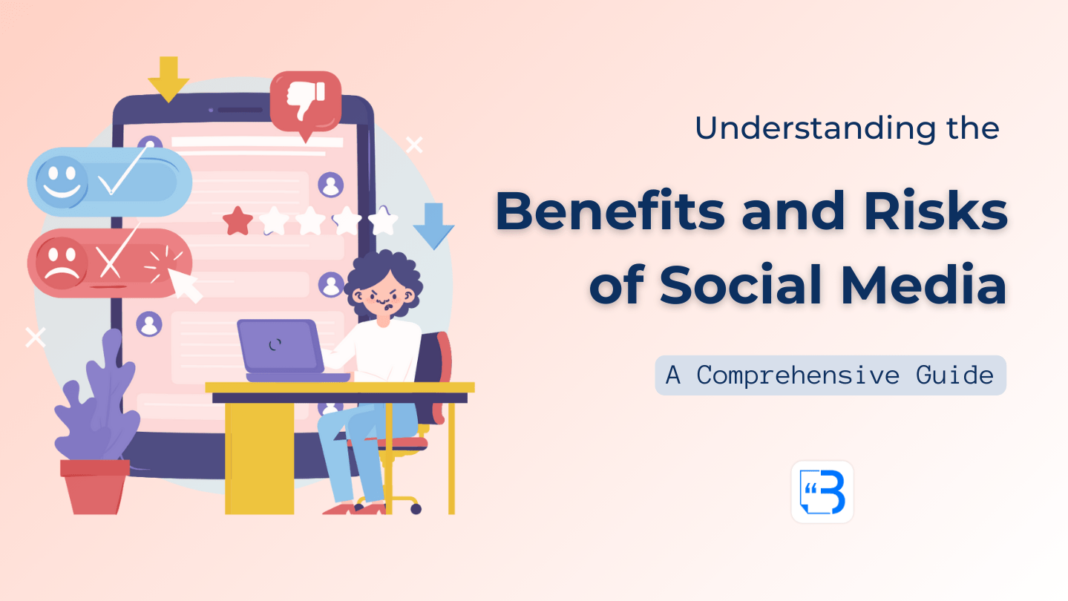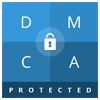Ever tried to picture the vast world of the internet? It’s massive, right? Right in its heart, social media shines, tying us all together. It’s where the energy of the youth and the experience of older folks meet, making age just a number. Who doesn’t love instant chats, knowing what’s happening around the world in a snap, or building those global connections? Yet, just like everything in life, there are two sides to this coin. On one side, we’ve got these amazing benefits of social media, and on the other, some challenges that might make us think twice.
Let’s face it; social media is the digital age’s superstar and it’s a tricky player, all in one. It’s as if the whole world’s right there on our screens, opening doors to chat, share, and learn. But with all these perks come some hitches. That’s why it’s super crucial to know the ins and outs, the benefits and risks of social media. And that’s what this guide’s all about – giving you a full view, ensuring your time online is a blast but also safe.
Table of Contents
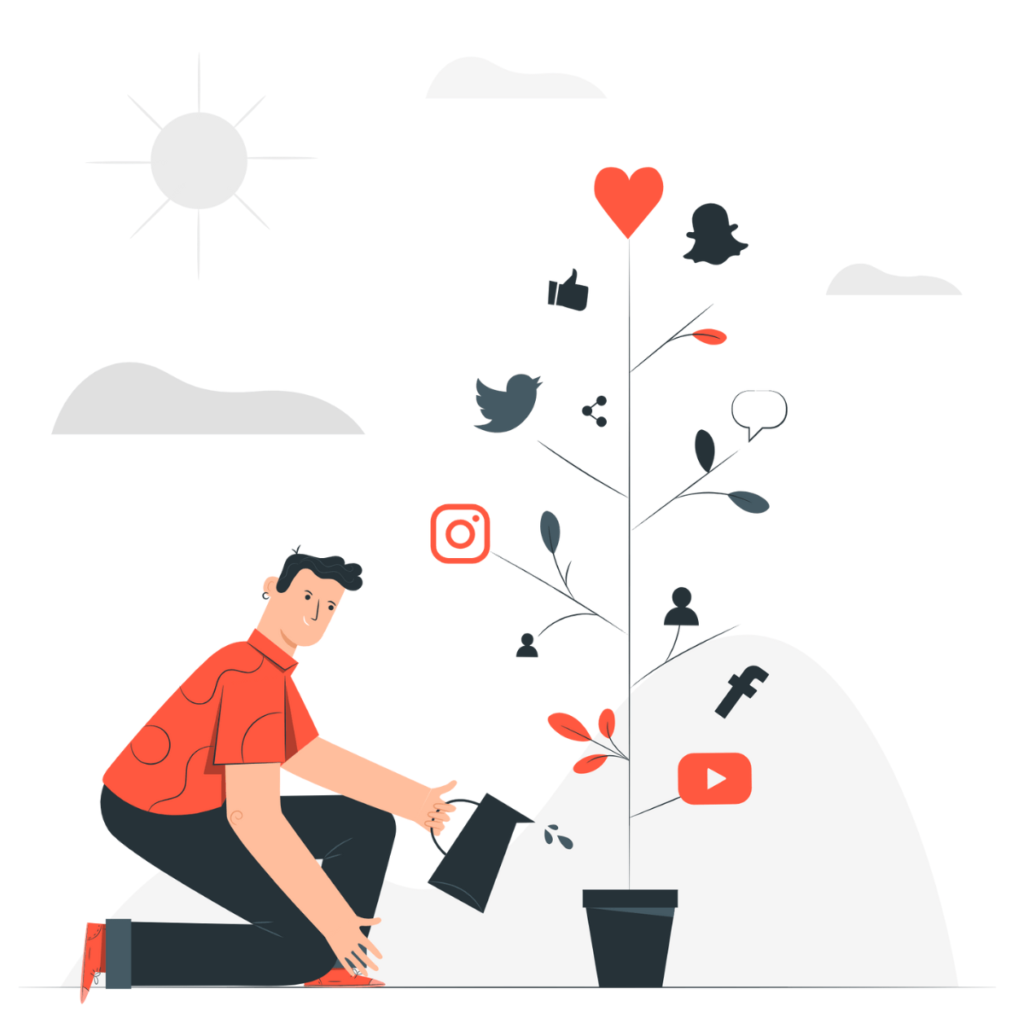
1. The Rise of Social Media
Tracing the evolution of communication, the transformative wave brought about by social media platforms stands out as a pivotal chapter. These platforms, which began as simple online hubs for friends to reconnect and share life updates, rapidly expanded their horizons. They tapped into the inherent human need for connection, validation, and expression, paving the way for the many benefits and risks of social media that we discern today.
From the initial platforms like Friendster and MySpace, the digital landscape evolved, giving birth to giants like Facebook, Instagram, and Twitter. These platforms offered more than just social connectivity. Businesses identified the vast potential in reaching and interacting with global audiences; educators leveraged them for enhanced collaborative learning; activists found a robust medium to amplify their voice globally, and creatives gained platforms to showcase their talents to vast audiences.
Moreover, the immediacy of these interactions, facilitated by social media, effectively dissolved geographical and temporal barriers. This ability to instantly share, comment, and connect across continents exemplifies both the benefits and risks of social media. For instance, a person in Australia can instantly share a moment with someone in Iceland, showcasing the unparalleled reach and connectivity, but also raising questions about data privacy and digital footprints.
In essence, the rise of social media is not just about technological advancement; it’s a complex interplay of human desires, opportunities, and challenges. As we navigate this digital age, understanding the benefits and risks of social media becomes imperative to use these tools effectively and safely.
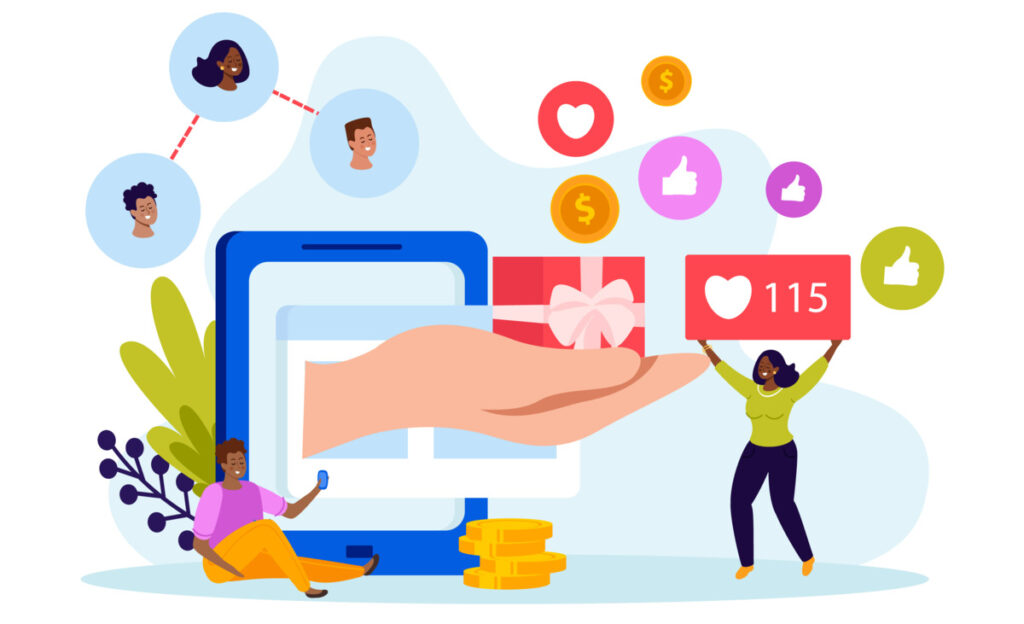
2. Benefits of Social Media
As we immerse ourselves in the digital realm, it becomes evident that social media is not just a fleeting trend but a transformative force influencing various aspects of our lives. From fostering global connections to opening up a world of learning and opportunities, the positive facets of these platforms are diverse and impactful. This section unveils the myriad benefits of social media, helping readers appreciate its value and potential in shaping personal, professional, and societal narratives.
i. Global Connectivity:
The universe of the internet has indeed shrunk the vast world into a digital village. Social media stands at the center of this phenomenon. Through platforms like Facebook, Instagram, and Twitter, people from every corner of the globe can effortlessly stay connected. Imagine a grandmother in New York watching a livestream of her granddaughter’s graduation in Tokyo. Or an entrepreneur in Kenya discussing business strategies with a counterpart in Brazil. This real-time global connectivity, eliminating miles and time zones, showcases the transformative power of social media.
ii. Educational Opportunities:
In the age of information, learning isn’t confined to the four walls of a classroom. Social media channels have become a vast ocean of knowledge. LinkedIn Learning offers courses ranging from graphic design to leadership training. YouTube, often termed the second-largest search engine, is brimming with tutorials on almost every topic imaginable. Moreover, specialized groups and communities on Facebook foster discussions, share resources, and provide peer support, enriching the learning experience.
iii. Business Advancement:
Gone are the days when businesses relied solely on traditional media for promotion. Social media has revolutionized the way brands communicate with their audience. Platforms like Instagram and Pinterest have become showcases for products, while Twitter offers real-time customer service. Furthermore, the rise of influencers on these platforms offers a more organic way for brands to reach potential customers. With analytics in hand, businesses can now refine strategies instantaneously, ensuring a more significant impact and return on investment.
iv. Social Causes and Activism:
The power of collective voices coming together on social media can’t be overstated. Platforms like Twitter and Instagram have provided activists a megaphone to the world. Hashtags like #BlackLivesMatter and #MeToo didn’t just trend; they stirred global movements, changing narratives and demanding action. Social media has enabled grassroots movements to gain global momentum, challenging the status quo and bringing about societal change.
v. Entertainment:
The entertainment quotient of social media is dynamic and ever-evolving. Platforms like TikTok have given rise to a new generation of celebrities and trends, with catchy dance routines and challenges becoming global phenomena overnight. Twitter, on the other hand, offers real-time commentary on global events, intertwined with a healthy dose of humor in its memes. Whether it’s watching a live concert on Instagram or exploring the latest trends on Snapchat, social media ensures there’s never a dull moment.
vi. Networking and Career Advancements:
In today’s professional world, networking plays a pivotal role, and social media platforms like LinkedIn have made this infinitely more accessible. Job seekers can connect with potential employers, professionals can exchange insights, and freelancers can showcase their portfolios to a worldwide audience. Through such platforms, career opportunities are no longer limited by geographic or social boundaries. The easy access to industry experts, potential mentors, and peers across the globe can be a game-changer for many in shaping their careers.
vii. Cultural Exchange and Global Awareness:
One of the more subtle yet profound benefits of social media is the window it provides into diverse cultures and lifestyles. Whether it’s an artist sharing traditional dance forms from India on Instagram, a chef from Italy teaching pasta recipes on YouTube, or a day in the life of a farmer in New Zealand on TikTok, these snippets of daily life offer invaluable insights into global cultures. Such exchanges foster understanding, tolerance, and a sense of global community. They break down stereotypes and allow us to celebrate both our differences and shared humanity.
In essence, the benefits of social media are multifaceted, touching virtually every corner of modern existence. From building bridges across continents, enabling lifelong learning, and fostering global movements, to providing daily entertainment and insights into diverse cultures, these platforms have reshaped the way we connect, learn, and entertain. Harnessing their potential wisely can enrich our lives in countless ways.
Check our related articles:
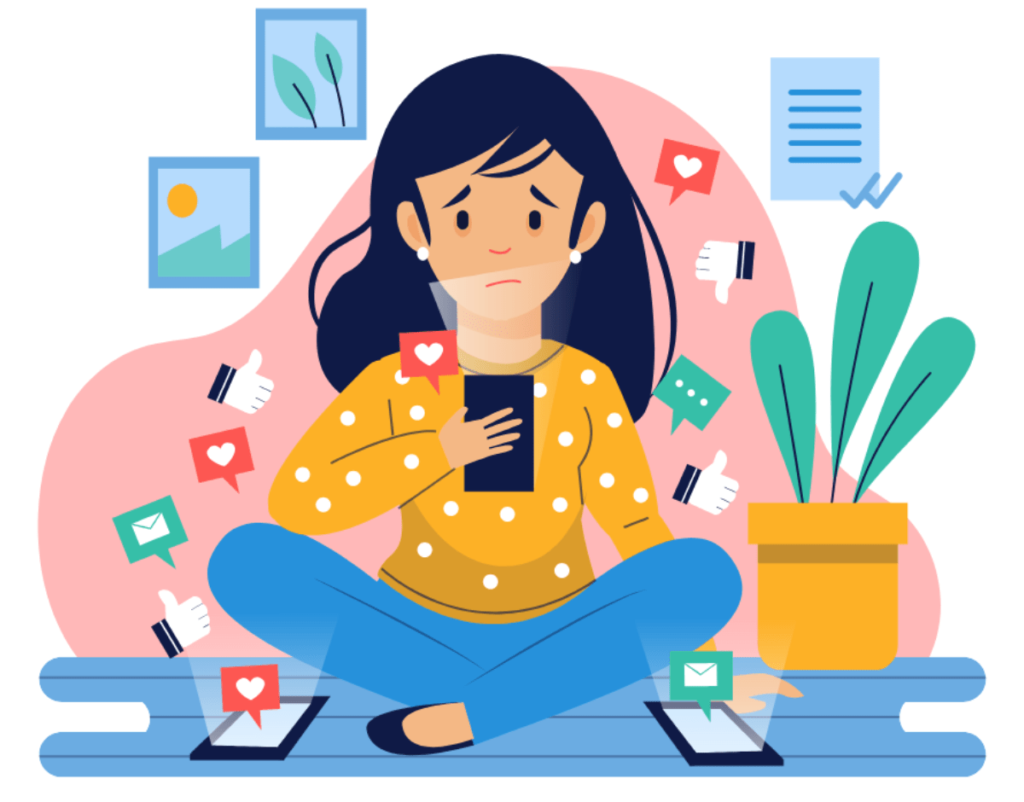
3. Risks of Social Media
While the benefits of social media are numerous, it’s crucial to navigate these platforms with an awareness of their associated risks. Balancing the positives with a deep understanding of potential dangers ensures a safer online experience.
i. Privacy Concerns:
As we curate our lives online, every shared detail becomes a piece of the vast puzzle that forms our digital identity. From casual check-ins at a local café to intimate family moments, the breadth of information is extensive. This data doesn’t just stay confined to our friend circle. Advertisers, third-party applications, and sometimes malicious entities can access and exploit this information. Data breaches at even well-established platforms expose millions of users to threats like identity theft, cyber-stalking, and even financial fraud. Hence, maintaining discretion in what we share becomes paramount.
ii. Mental Health Impact:
On scrolling through social media, we’re often met with perfectly captured moments, leading us to believe in a perpetually gleaming world for others. However, behind these curated feeds lies the reality of selective sharing. The constant comparison with these seemingly perfect lives can seed feelings of inadequacy. For younger users, especially, this warped perception can exacerbate issues of self-esteem, causing anxiety, depression, or feelings of isolation. The mental health implications are so significant that platforms themselves, like Instagram, have considered removing ‘like’ counts to reduce the pressure.
iii. Cyberbullying:
The vastness and perceived anonymity of the internet can sometimes give individuals a misplaced sense of empowerment to harm others. From spreading defamatory rumors and posting derogatory comments to sending threatening messages, cyberbullying can take many forms. For victims, especially the younger audience, such experiences can lead to severe emotional trauma, decreased self-worth, and in extreme cases, even self-harm.
iv. Spread of Misinformation:
The adage, “Don’t believe everything you read,” holds particularly true for social media. With the ease of content creation and distribution, false information can propagate rapidly. Whether it’s fabricated stories with political agendas, health myths, or misleading financial advice, the consequences of such misinformation can range from mere confusion to significant real-world ramifications. The responsibility, therefore, lies with both platforms to curb such spread and users to validate information before believing or sharing.
v. Addiction:
Designed to capture and retain user attention, the mechanics of social media platforms can foster addictive behaviors. The immediate gratification from notifications, the allure of viral trends, and the FOMO (Fear of Missing Out) can lead to compulsive checking of feeds. Over time, this digital dependency can disrupt daily routines, interfere with face-to-face relationships, and have physical repercussions like disrupted sleep patterns, eye strain, and even postural issues from prolonged usage.
vi. Financial Scams and Phishing:
With the increasing integration of commerce and social media, there has been a surge in platforms becoming hotspots for financial deceptions. Fraudulent profiles or seemingly genuine advertisements might showcase too-good-to-be-true offers or investments. Drawn by these prospects, many users sometimes inadvertently share crucial financial information. Falling prey to such schemes can lead not only to immediate financial losses but also put individuals at risk of longer-term financial frauds and identity theft.
vii. Echo Chambers and Polarization:
One of the less apparent risks of social media is the creation of ‘filter bubbles’—a state where algorithms tailor content to a user’s existing beliefs and preferences, limiting exposure to diverse viewpoints. This constant reinforcement can inadvertently isolate individuals within their ideological bubbles, making them susceptible to confirmation bias. This phenomenon can hinder open-mindedness, leading to heightened societal divisions and a decreased willingness to engage in constructive dialogues with those holding differing opinions.
The digital landscape of social media, while laden with opportunities, also manifests the complex interplay of the benefits and risks of social media. From personal challenges like mental well-being and the menace of cyberbullying to broader societal concerns such as misinformation and ideological isolation, the spectrum of risks underscores the urgency for discernment, awareness, and proactive measures. Recognizing and understanding these benefits and risks of social media is pivotal in charting a path toward a safer, more informed, and fulfilling online journey.
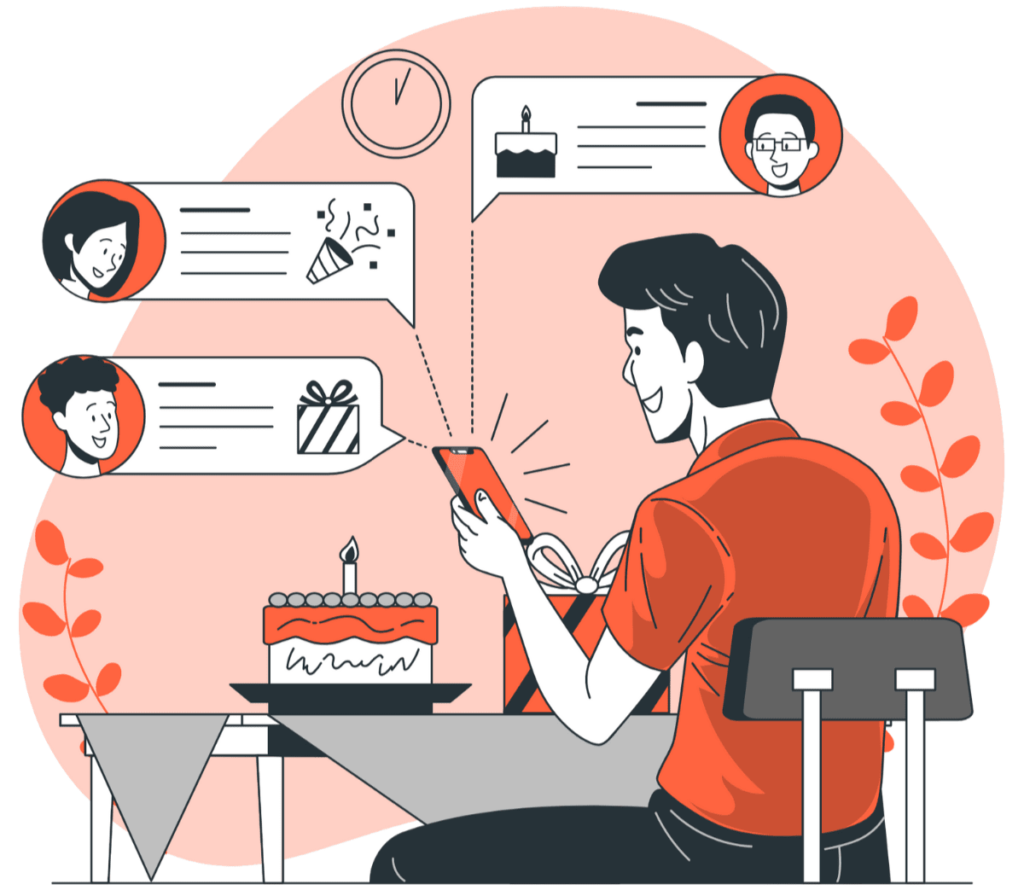
4. Balancing the Scales: Tips for Safe and Effective Social Media Use
To navigate the vast world of social media with poise, one must find equilibrium. Recognizing the benefits and risks of social media equips us with knowledge, but it’s the daily practices that shape our experience. Here are some tips to ensure your journey on these platforms is both rewarding and safe:
i. Limit Usage:
In our hyper-connected world, it’s tempting to be continually plugged in, with notifications serving as constant distractions. By designating specific times or even setting app timers for social media interactions, you not only prevent potential overexposure but also elevate the quality and purposefulness of your online engagements.
ii. Privacy Settings:
The digital breadcrumbs we leave can piece together a vivid picture of our lives. Diligently reviewing and adapting privacy settings ensures a cloak of control over what’s visible and to whom. Regular audits of these settings help maintain a shield against unwanted intrusions into our digital lives.
iii. Fact Check:
Social media, with its rapid information dissemination, can sometimes turn into a hotbed for rumors and unverified news. By taking that extra moment to validate information from reputable sources before sharing, you become a beacon of reliability in an often murky digital information ecosystem.
iv. Positive Spaces:
Your virtual surroundings can profoundly influence your mental and emotional state. By consciously curating your feeds and choosing to engage with uplifting and constructive content, you’re shaping a digital environment that fosters positivity. When faced with negativity, exercising the power to mute, block, or report ensures your space remains untainted.
v. Digital Detox:
The incessant digital buzz can sometimes blur the lines between our online and offline worlds. Designating periods, whether short or extended, to disconnect and immerse in the tangible world around us can rejuvenate the mind, offering fresh perspectives when we return to our screens.
vi. Educate and Stay Updated:
The landscape of social media is ever-evolving, with new features, trends, and potential threats emerging regularly. By educating yourself about the latest in digital safety, platform updates, and emerging trends, you can stay ahead of potential pitfalls and make the most of new opportunities.
vii. Engage Mindfully:
Remember that behind every post, comment, or share is a real person. Engage with empathy, avoiding confrontations or getting embroiled in negative discussions. Taking a moment to think before you post or react can prevent misunderstandings and ensure more positive interactions.
Blending these practices with the earlier suggestions ensures a holistic approach to navigating the benefits and risks of social media. By staying informed, engaging with empathy, and setting boundaries, you set the stage for a more enriching and safer online journey.
Conclusion: Benefits and Risks of Social Media
In today’s digital age, social media stands as a beacon of connectivity and opportunity. It bridges cultural gaps, amplifies marginalized voices, and provides platforms for influence and change. Businesses find unparalleled reach, and grassroots movements gain momentum at speeds previously unthinkable. Yet, intertwined with these benefits are undeniable challenges: privacy threats, mental health considerations, misinformation, and the shadow of cyberbullying.
Navigating the benefits and risks of social media isn’t a passive journey. It demands informed, proactive participation. Adopting best practices—mindful engagement, regular digital detoxes, and vigilant privacy settings—transforms the user experience. As social media platforms evolve, our approach should too, constantly adapting and learning. The ongoing discourse on social media’s pros and cons underscores the need for vigilance and adaptability, ensuring an enriching yet safe digital odyssey.


